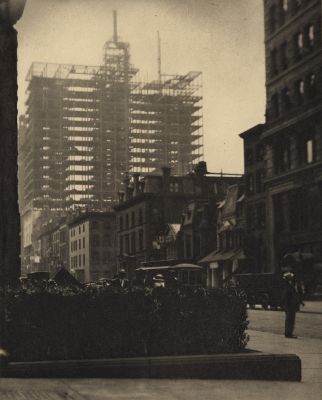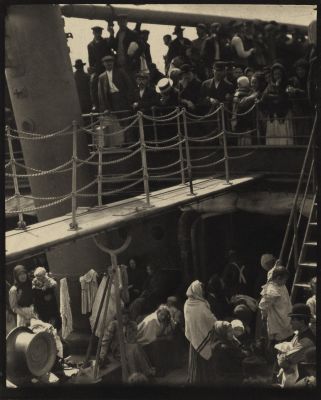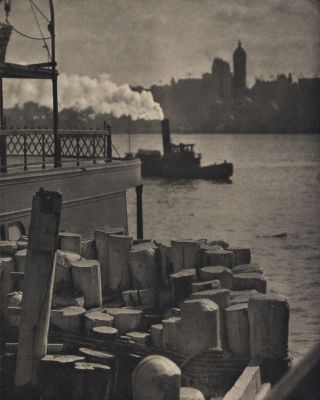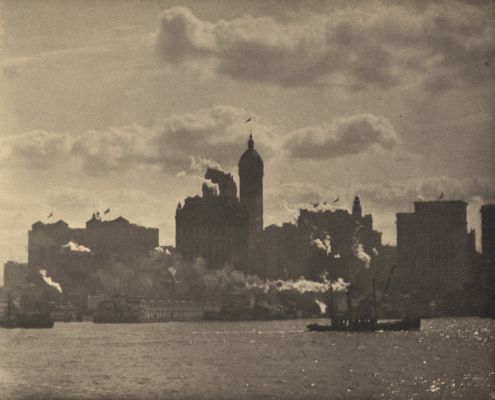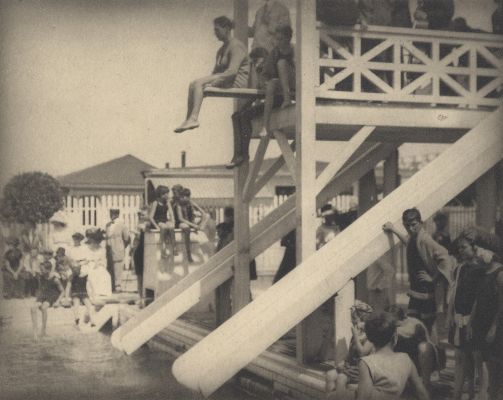
Title
The TerminalArtist
Stieglitz, Alfred (American, 1864-1946)Key FigurePublication
Camera Work XXXVIDate
1892Process
PhotogravureAtelier
Manhattan Photogravure Company, NYImage Size
12.1 x 15.9 cm
The Terminal is one of the earliest and most important of Stieglitz’s New York City images. Made some five years before Eugene Atget began documenting the streets of old Paris, The Terminal speaks to the dawning realization in Stieglitz of the potential for artistic expression in his hometown. ‘From 1893 to 1895 I often walked the streets of New York downtown, near the East River, taking my hand camera with me. I wandered around the Tombs [jailhouse], the old Post Office, Five Points. I loathed the dirty streets, yet I was fascinated. I wanted to photograph everything I saw,’ he recounted to a friend. ‘[One day] I found myself in front of the old Post Office. The Third Avenue street railway and the Madison Avenue car systems had their terminals there, opposite the old Astor House. It was extremely cold. Snow lay on the ground. A driver in a rubber coat was watering his steaming car horses. How fortunate the horses seemed, having a human being to tend them … The steaming horses being watered on a cold winter day, the snow-covered streets … [expressed] my own sense of loneliness in my own country.’ [1]
Having returned from almost a decade in Europe, lower Manhattan, with its throngs of workers and construction projects, docks, subways and dirty streets, was an utter contrast to picturesque Europe. The grandeur and forces of modernity coursing through the city, however, inspired a body of work that blazed a trail for the fledgling art of photography. Like The Hand of Man and The Steerage, The Terminal was reproduced as a small-format photogravure in Camera Work XXXVI (1911).
It’s as beautiful an image as exists, with its variety of textures, interplay of angle and curve, marriage of the lyrical (the steam rising from the horses’ flanks) and prosaic (the slush beneath their hooves). The photograph epitomizes both Pictorialism, with its aim to elevate photography through aping the appearance of painting and etching, and looks ahead to classic 20th-century photography, with its stunning specificity and forthright contemporaneity. [2]
Reproduced / Exhibited
America & Alfred Stieglitz: A Collective Portrait. Garden City, N.Y: Literary Guild, 1934. (cover)
At The Still Point, Photographs From The Manfred Heiting Collection, Vol 1, Cinubia, 1995, pl 284, pg309
Camera Work, The Complete Illustrations 1903-1917, Taschen, 1997 pg 596
Photography From 1939 to Today, George Eastman House,, Taschen, pg 391
Gernsheim, Helmut. Creative Photography. Aesthetic Trends 1839-1960. [with Illustrations.]. London: Faber & Faber, 1962. p. 138
Greenough, Sarah, and Alfred Stieglitz. Alfred Stieglitz: The Key Set : the Alfred Stieglitz Collection of Photographs. Washington, D.C: National Gallery of Art, 2002. Pl 93
Stieglitz, Alfred, Richard Whelan, and Sarah Greenough. Stieglitz on Photography: His Selected Essays and Notes. New York, NY: Aperture Foundation, 2000. p. 26
Frank, Waldo D. America and Alfred Stieglitz: A Collective Portrait. New York: Aperture, 1979. pl. 2
Doty, Robert M. Photo-secession: Photography As a Fine Art. N.Y: Eastman, 1960. plate II..
Homer, William I. Alfred Stieglitz and the American Avant-Guarde. Boston: New York Graphic Society, 1979. no. 4.
Hoffman, Katherine. Stieglitz: A Beginning Light. New Haven: Yale University Press, 2004. no. 94.
Homer, William I. Alfred Stieglitz and the Photo-Secession. Boston: Little, Brown and Company, 1983. no. 10.
Jeffrey, Ian. Photography: A Concise History. London: Thames and Hudson, 1981. no. 60.
Johnston, Patricia A. Seeing High & Low: Representing Social Conflict in American Visual Culture. Berkeley: University of California Press, 2006. fig 11.1
Kruse, Margret. Kunstphotographie Um 1900: D. Sammlung Ernst Juhl; Hamburg: Museum für Kunst u. Gewerbe, 1989 pl. 864
Marien, Mary W. Photography and Its Critics: A Cultural History, 1839-1900. Cambridge: Cambridge University Press, 2011. no. 66
Masterpieces of Photography From the George Eastman House Collection, Robert A. Sobieszek, Abbeville Press, 1985, pg 197
Other Collections: MMA, Philadelphia Museum of Art, Musee d’Orsay, GEH, MOMA, Getty Museum
Rosenblum, Naomi. A World History of Photography. New York: Abbeville Press, 2008. no. 312.
Rocha, Regina M, Paul Strand, and Helouise Costa. A Poética Fotográfica De Paul
Strand. São Paulo, Brazil: Editora da Universidade de São Paulo, 2012. Fig. 16
Roth, Andrew, and Richard Benson. The Book of 101 Books. New York: 2001 p. 41
The Art of Photography, 1839-1989, Yale University Press, 1989, pl 197
Vogt-O’Connor, Diane, and Joan Redding. Guide to Photographic Collections at the Smithsonian Institution. Washington: Smithsonian Institution Press, 1989. #82-6232
Wallraf Richartz Museum Koln – Hundert Jahre Photographie 1839-1939 aus der Sammling Gernsheim, London, 1959, pl 36
Weaver, Mike. The Photographic Art. Edinburgh, 1986. no. 34
References
[1] Weston Naef, In Focus: Alfred Stieglitz: Photographs from the J. Paul Getty Museum, J. Paul Get t y Museum, Malibu, 1995, pl. 2, p. 12.
[2] By Mark Feeney https://www.bostonglobe.com/arts/art/2017/07/26/small-but-choice-stieglitz-and-sheeler-shows-mfa/N0rFikfxAf6tJ499UMqzeL/story.html
Marianne Fulton Margolis (ed.), Camera Work: A Pictorial Guide, Dover, New York, 1978, p. 101.
William Innes Homer, Alfred Stieglitz and the Photo-Secession, Lit tle Brown and Co., Boston, 1983, p. 18 .
Richard Whelan, Alfred Stieglitz: A Biography, Lit tle Brown and Co., Boston, 1995, n.p.
Sarah Greenough, Alfred Stieglitz: The Key Set, Volume One 1886-1922, Abrams/National Gallery of Art , Washington, D.C., 2002, pp. 56-59, cat. nos. 92-96.
Malcolm Daniel, Stieglitz, Steichen, Strand: Masterworks From The Metropolitan Museum of Art, The Metropolitan Museum of Art , New York, 2010, pl. 5.




